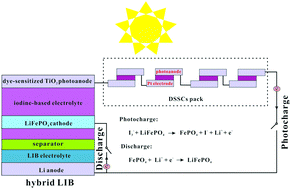Available photo-charging integrated device constructed with dye-sensitized solar cells and lithium-ion battery
Abstract
The development of self-chargeable lithium-ion batteries is of great significance for expanding the usable range of the lithium-ion battery and it has received intensive attention from numerous researchers. Solar cells can generate electricity from the sunlight and ensure sustainable access to electrical power for charging lithium-ion batteries. Herein, a photo-charging integrated device is constructed by combining four conventional dye-sensitized solar cells and a three-electrode hybrid lithium-ion battery, including a dye-sensitized TiO2 photo-anode, LiFePO4 electrode and metal lithium electrode. When the device is operated under solar illumination, DSSCs can match the charging voltage for the hybrid lithium-ion battery. The LiFePO4 electrode in the three-electrode device plays two roles, serving as a reversible redox agent for the regeneration of dye and as the cathode for lithium-ion batteries. The integrated device can effectively harvest solar energy and store it in situ within the hybrid lithium-ion battery through the photo-charging process. The proposed strategy is in favor of exploiting the small-sized, light-weight, self-chargeable battery and may have the potential to be employed as the power supply for miniaturized sensors and mobile devices.



 Please wait while we load your content...
Please wait while we load your content...